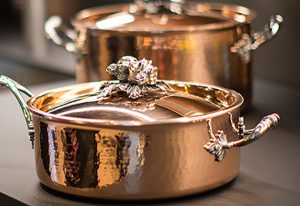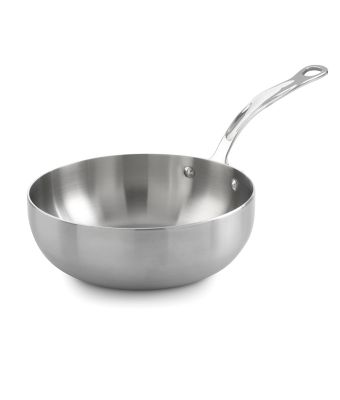A Look at Different Pan Materials & Their Benefits

When buying a set of kitchen pans, you might be surprised at just how many different materials are available to choose from.
That’s why we’re going to quickly run through the main options, what they’re good for, and when you shouldn’t be using them too!
In this guide:
- The Intro
- Cast Iron
- Stainless Steel
- Copper
- Aluminium
- Non-Stick
Cast Iron
One of the most popular and versatile materials when it comes to cookware is cast iron, renowned for its durability.
Cast iron can be used almost anywhere, whether it be on the stove or grill or in the oven and conducts heat very well, meaning once they’re hot, they stay hot for a long time.
There’s also no need to worry about damaging the pan with your metal utensils as they won’t scratch the surface and they’re relatively cheap compared to some other metals.
One of the main disadvantages of using cast iron is that it can be a little harder to take care of, but there are also some myths surrounding this too and if you’re willing to put in a bit of extra time and care, they can be a great option. (Check out this guide from Kitchen to find out how best to look after your cast iron pans.)
It’s also a little tricky to get them to heat up evenly, meaning that you might have to pre-heat and rotate them a little every few minutes to get them properly heated up.
Something else to remember is that iron is a reactive material, so some acidic foods can end up with discolouring or slightly strange tastes.
While this isn’t usually too much of an issue as long as you’re not cooking for too long, you can also get enamelled cast iron pans which have a non-reactive coating, although this will be more expensive.
Stainless Steel
Stainless steel is a reliable and non-reactive material that’s resistant to rust, corrosion and general wear and tear and can also easily be cleaned in the dishwasher too.
Unlike cast iron though, it’s not very good at conducting heat, which can sometimes be an issue, although there are stainless steel pans which have been reinforced with the core of another material such as aluminium or copper.
Stainless steel is also generally affordable which is good, although the better ones will cost you a little bit more.
Alternatively, you might want to look into carbon steel, which is generally seen as a midpoint between stainless steel and cast iron, with many of the characteristics of cast iron, but also lightweight and easy to look after like stainless steel.
Copper
Copper pans are great at conducting heat and react quickly to changes in the temperature which gives you more control when you’re cooking.
This also means that you don’t have to worry about preheating, as copper will heat up very quickly, even without a high flame.
However, copper is also a reactive material, so will need to be lined with something else such as stainless steel and it’s also one of the more expensive materials when it comes to cookware.
Copper also shows signs of age and starts to lose its shine over time, so you might have to give it a polish every now and then to keep it looking at its best.
Aluminium
Naturally, aluminium is a very soft and reactive material, so it has to be processed before being used in pans and is usually chemically treated to harden and make it safe for use in the kitchen.
Like copper, it’s an excellent conductor or heat and is also very lightweight, while also being scratch resistant and strong, making it an excellent choice.
Aluminium is particularly preferred by bakers, although it can also cause over-browning of some sweet baked goods.
Non-Stick
Non-stick pans can be made from a variety of different materials such as the ones we’ve already mentioned, although they’re coated with a special non-stick compound such as Teflon.
Cooking with a non-stick pan means that you don’t need to use as much fat and some delicate foods like fish and eggs won’t be as likely to break apart.
Some have raised issues over the safety of non-stick pans, although research has shown that as long as the pan isn’t overheated, they’re perfectly safe to use (high heats could cause the coating to break down).
One of the main downsides of non-stick pans is that they generally have a shorter life than other types of material although this depends on the quality of the pan and how well you look after it.
One other thing to bear in mind is that you can’t really use metal utensils with non-stick pans as they’ll scratch the surface of the pan.
The right pan material ultimately comes down to what you’re cooking and how you’re cooking it, but hopefully, the tips above have helped to give you some guidance.

